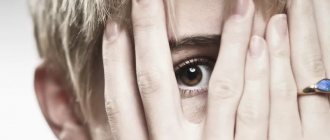- Emotional disorder in children
- Mixed behavioral and emotional disorder in children
If a patient is diagnosed with an emotional disorder, it is often accompanied by the development of mental illnesses: neuroses, at various stages of schizophrenia. Since psychiatry, as well as psychologists, study this category of disorders, it is important to consider all possible aspects of the disease.
Causes and provoking factors
The main cause of emotional problems is considered to be organic damage to brain structures.
And:
- heredity - if one of a person’s close blood relatives suffered from behavioral disorders, the risk of similar problems increases by 50%;
- history of infectious brain damage (encephalitis, meningitis);
- previous head injuries;
- bad habits;
- endocrine diseases, for example, diabetes;
- a difficult childhood caused by traumatic situations provoked by relatives;
- prolonged stress;
- experienced violence.
If there are several factors influencing at the same time, this significantly increases the likelihood of developing emotional problems.
Definition of the concept
People are emotional by nature. They react to what is happening around them, assessing events. There is always a response, and the reaction can be violent or restrained. In psychology, emotional dullness is a special state of the individual’s psyche, which is expressed by the loss of higher emotions.
Loss of gratitude, tolerance, compassion and shame is a sign of the following diseases:
- schizophrenia;
- dementia;
- damage to the cerebral cortex.
Experts consider this state of the emotional sphere as “moral idiocy.” The second name for this feature is affective dullness.
Emotional dullness in schizophrenia develops rapidly, leading to irreparable changes in the personal sphere. A person often develops vulnerability in areas that are tolerated by normal people without problems. A striking example is the patient’s lack of worries about the death of a relative and an outburst of anger due to the fact that someone used his dishes. Affective dullness makes an individual unpredictable.
The danger of this feature is that a person becomes more alienated every year. But one should not confuse a dangerous state with ordinary coldness, which is a defensive reaction of the individual. Anxiety grows when the patient pushes away people who were once close and dear to him.
Characteristic
Emotional problems have several key characteristics. Every person who has such mental disorders experiences negative emotions, manifested by apathy, depression, causeless nervous excitability and even suicidal thoughts. Hostility toward others is another core characteristic of emotional problems. A person does not adequately assess risks, and this is explained by his impulsiveness and inability to objectively assess the world around him. With a prolonged disorder, suicidal thoughts and auto-aggression arise - self-mutilation.
Signs include:
- development in adulthood;
- a person cannot control his behavior either alone or in society;
- inappropriate behavior leads to serious problems in relationships with relatives, colleagues, superiors and other people from the environment.
Development mechanism
In psychology, there are two groups of factors contributing to the development of psycho-emotional disorders: internal conditions and external influences. Internal conditions include features of the cognitive sphere: thoughts, ideas, fantasies. A negative assessment of events provokes negative emotions. Another group of internal factors are the psychophysiological characteristics of the body. The biological basis of emotions is the neurohumoral processes of the limbic and diencephalic systems of the brain, the exchange of serotonin, adrenaline, norepinephrine, and dopamine. An imbalance of these substances leads to the development of affective disorders.
Reactions to external environmental conditions can be innate and conditioned. Genetically embedded ways of responding - fear, aggression - are the basis for the formation of more complex emotional and behavioral patterns. During life, the development of affective disorders is facilitated by the processes of experiencing and consolidating traumatic experiences. Repetition or partial similarity of current events with past ones that caused negative experiences becomes the cause of psycho-emotional disorders.
What are emotional disorders?
Emotional problems from the point of view of psychiatry are a person’s inadequate perception of others and situations occurring in his life. The patient cannot control the intensity of the expression of emotions, which is why behavior is assessed by others as inadequate and strange.
Emotional disorders are conventionally divided into 2 groups:
- Emotional disorders.
- Problems with the adequacy of emerging emotions.
Disorders of emotional perception include:
- affect – uncontrollable emotions that interfere with a sober assessment of the environment;
- hyperthymia - causeless joy, accompanied by overly pronounced facial expressions;
- euphoria – occurs due to the use of alcohol, drugs and is manifested by nervous agitation;
- hypotomia - manifested by loss of strength, depression, negative assessment of the environment;
- apathy – lack of interest in something, ignoring problems;
- anger – nervous excitement that develops into uncontrollable aggression;
- lack of emotions - emotional coldness and alienation, provoking severe stress;
- phobias – obsessive fear of something;
- obsession - the desire to perform some action at any cost;
- ambivalence – simultaneous experience of opposite states (apathy + obsession, hyperthymia + hypotomia).
- Violations of the adequacy of emotions are manifested by the following disorders:
- dysphoria – intense anger that occurs in response to a minor stimulus;
- amymia – absence of facial expressions (“stony” face);
- paramimia - facial expressions that do not correspond to the experienced feelings;
- hypermia is rapidly changing facial expressions.
Decreased emotional background
Sysuev Oleg Mikhailovich Neurologist
✓ Article verified by a medical expert
A decrease in emotional background is a neurological disorder that leads to a depressive state. People of different ages suffer. Nowadays, the decrease in the emotional component is a global problem, which is difficult to cope with on your own. Doctors believe that modern lifestyle affects people's emotional state.
Types of Neurological Disorders
The human nervous system remains a mystery to this day. Making an accurate diagnosis is quite difficult. Mental, emotional and physical stress is a reality that leads to various mental disorders.
Let's consider the main types of violations:
- Obsessive-compulsive disorder - obsessive memories of a difficult childhood, bad deeds, past experiences. Highly intelligent people suffer. Disorders can be episodic, chronic, or progressive. A person constantly feels a sense of anxiety and restlessness. Exacerbation of the disorder occurs during the change of seasons and changes in atmospheric pressure.
- Neurasthenia - increased irritability, decreased mental performance, tearfulness for no reason. The person loses his ability to work. This condition is caused by depression of the nervous system due to psychological trauma, poor sleep, and imbalanced diet.
- Hysteria is the inability to control one's behavior. Often accompanied by seizures, increased irritation, laughter with tears. The disorder is characterized by a tendency to self-hypnosis and affective behavior. Hysteria manifests itself in the patient's constant desire to be the center of attention. The seizure usually lasts as long as people around are worried. The disorder develops as a consequence of psychological trauma.
- Autonomic dysfunction is the irregularity of signals from the autonomic nervous system. The deterioration of emotional well-being progresses. It occurs on the basis of stress and is provoked by a stressful state. They are part of a functional lesion of the nervous system.
- Depression is a mental condition caused by decreased mood, impaired thinking, and motor retardation. Signs of the disorder include low self-esteem, inadequate feelings of guilt, decreased appetite, sleep disturbances, and thoughts of suicide.
Depression is caused by prolonged stay in a state of hopelessness. The body loses its protective functions, mood worsens, and problems begin. A person needs professional psychological help.
Causes and symptoms
The general emotional state that colors a person’s everyday life is called mood. Mood is the body’s reaction to the direct consequences of events. A sad, depressed and depressed mood leads to a decrease in emotional background.
Causes of the disorder:
- psycho-emotional stress;
- genetic predisposition;
- chronic fatigue;
- hormonal disorders;
- unfavorable relationships;
- neurological disorders.
Symptoms of decreased emotional background:
- rapid fatigue;
- headache;
- poor sleep;
- loss of appetite;
- exacerbation of diseases;
- decreased concentration;
- memory impairment;
- anxiety and restlessness;
- craving for alcohol;
- excessive stress
.
If a bad emotional state drags on, this is a reason to consult a specialist.
Which doctor treats you?
Modern scientists are constantly researching neuropsychiatric diseases. A professional approach and innovative equipment allow a more accurate diagnosis. A decrease in emotional background is treated by a neurologist. The doctor will conduct an examination, diagnose, prescribe therapy and select a rehabilitation program taking into account the individuality of the patient.
Diagnosis and treatment
During the examination, the patient talks about the problem and undergoes tests. To identify the cause of a decrease in emotional background, magnetic resonance imaging and ultrasound examination of individual organs are prescribed to exclude or confirm the presence of a neurological disease. Often the problem is psychological in nature. The patient is prescribed a variety of tests. Treatment for decreased emotional background is based primarily on the use of sedatives and antipsychotics. It is necessary to relieve anxiety, tension, irritability. The vitamin complex will help fill the body with energy and improve cardiac function.
Alternative technique:
- Breathing exercises and fitness. Exercise will help you find peace of mind. Diaphragmatic breathing makes it possible to saturate the brain with oxygen, achieve calmness and concentration. Gymnastics can be done during the working day.
- Relaxation technique is a calming therapy aimed at relieving muscle spasms, stimulating blood circulation, and regulating immunity. During classes, stress is relieved.
- Yoga and meditation are a way to move away from pressing problems and get rid of depression.
- Psychocorrection - many methods of psychological influence. The specialist will select the appropriate therapy for the patient based on personal characteristics. This is a way to find and solve a problem that has caused an emotional disruption.
- Balanced nutrition - pay special attention to this issue. Heavy food adversely affects the functioning of the body, worsens mood, and disrupts the rhythm.
A magic pill that will quickly relieve a decrease in emotional background has not yet been invented. You need to gain patience and strength to cope with emotional instability. Disorders accumulate over years, so treatment and recovery will take some time.
Rehabilitation and lifestyle
When treating a decrease in emotional background, your lifestyle needs to be completely changed. Review your daily work and rest schedule, if possible, get rid of or reduce bad habits, and walk more in the fresh air. Listen to your doctor's recommendations.
Symptoms
Emotional problems are varied. But there are typical symptoms for them that create the clinical picture necessary to diagnose the patient. Thus, human behavior is controlled only by emotions, against the background of which the ability to objectively assess life situations is lost. All actions are taken under the influence of momentary desires. Changeable mood makes it impossible to make plans and keep promises to others. A minimal stimulus is enough to provoke uncontrolled aggression, nervous agitation and other behavioral disorders in the patient. A person often experiences suicidal and depressive thoughts, which indicates long-term emotional problems.
Against the background of symptoms of emotional disorders, the quality of life deteriorates. This is manifested by conflicts with others, the inability to conscientiously fulfill official duties.
Emotional and behavioral disorders (psychiatry)
Disorders of emotions and behavior can act as an independent, primary disease, or become a side symptom as a result of neurosis, depression, or severe nervous shock.
Disorders of behavior and emotions in a child
In a child, the disorder manifests itself as the inability to independently plan one’s own time, control emotional manifestations and reactions, and organize behavior in accordance with generally accepted norms.
The main symptoms include the following:
- Aggressiveness
- Refusal to obey adults
- Excessive cruelty
- Disobedience
- Pugnacity.
The reasons why a child may develop a behavioral disorder can be divided into several categories:
- Physiological. Manifests itself in hormonal changes and disturbances in metabolic processes. As a result of the development of cerebral palsy, epilepsy, schizophrenia, as well as increased irritability.
- Psychological. Occurs as a result of the child's emotional instability. He may develop an unrealistic self-esteem, a depressed emotional background, and constant self-blame may prevail.
- Family relationships. As a rule, the disorder occurs as a result of constant conflicts between parents. Most often they exhibit immoral behavior, use drugs or alcohol, and often have mental disorders.
Before starting treatment for a pathology, the treating specialist tries to establish the cause of the disorder, as well as organize testing for the child to find out how much it is progressing.
Diagnostics
A psychiatrist diagnoses emotional problems. To make a diagnosis, a list of typical manifestations of pathology is taken into account:
- Inadequacy of emotions.
- Lack of self-control.
- Behavioral disorders affect all areas of life.
- There were problems with social adaptation.
- The patient had previously been diagnosed with organic brain lesions.
- The man has experienced psychological trauma.
If the disorders correspond to at least three points on the list above, the psychiatrist will diagnose emotional disorders and develop an individual treatment regimen.
The meaning of psychotherapy
In people with impoverished emotions, dreams also disappear. The absence of imaginary actions in a dream leads to internal devastation. Loss of senses does not affect life expectancy in any way, but sharply reduces its quality. Experts recommend using the following techniques:
- Gestalt therapy;
- art therapy;
- suggestion.
You need to be patient during the treatment process. When the patient becomes interested in creativity, we can talk about success, since it is closely related to the manifestation of emotions. It is advisable to motivate the individual to create something colorful and unusual: paintings, crafts, works on paper.
The goal of psychotherapy for the patient is to learn to express emotions. Then work is carried out with comprehension and recognition of feelings. The mentee must describe them, expand his own vocabulary and study materials, as well as monitor the reactions of other people. Additionally, the patient receives medications that suppress physiological problems.
Emotional dullness is not only a condition when the patient is afraid of change. He feels the emptiness inside himself and strives to fill it with anything. The result of treatment depends on the desire of the person himself to change his quality of life for the better.
In Gestalt therapy, a person is a holistic image, the integral parts of which are body, soul and spirit. With the help of such a technique, a person will be able to experience feelings, as well as apply them to the experience gained. As a result of the experience, the patient completes the situation in the sense that it acquires clear features.
Psychology teaches us to experience “liberated” feelings without compromising the patient’s mental health. Success can be judged when the student begins to associate events with emotions rather than with details. At the same time, the patient’s imagination develops, he describes what is happening in colors.
Treatment
Treatment for emotional disorders includes:
- Taking medications is prescribed only by a doctor for organic brain damage and severe psycho-emotional abnormalities. The choice of medications depends on the specifics of the disorder. For apathy, depression and suicidal tendencies, antidepressants are prescribed. Taking tranquilizers is advisable for panic attacks, attacks of uncontrolled aggression, and obsessions. For increased excitability, antipsychotics are prescribed.
- Psychotherapy is the basic method of treatment. The correction program for psycho-emotional problems is developed individually, taking into account the causes of behavioral deviations, the patient’s condition and medical history.
The patient may be hospitalized in a hospital. The reasons for this decision include the statement of the patient’s relatives about the need for his hospitalization in a psychiatric clinic. Such a measure is provided if the patient’s behavior threatens the health and lives of others.
Consultations
Psychotherapist
Group psychotherapy
Psychologist
Family psychotherapy
Examples from life
In psychiatry, emotional dullness is observed when talking with such patients. In a state of remission, patients are able to talk about their peculiarities. A patient at one of the clinics admitted to doctors that the emotions she was holding back were a strong cry that could hit everything around her.
When the doctors asked how the ward could restrain such feelings, she declared her will. Another woman with schizophrenia said that suppressed emotions would inevitably cause an earthquake on the planet. When there is no time for analysis, a person stops contacting reality, thereby destroying his personality.
Emotional dullness is also observed when a person is exposed to destructive factors at an early age. The reason for this condition is always emotional. There is a known case where impoverishment of feelings developed in a woman who was spoiled by her parents from birth and got everything she wanted.
Until the age of five, she was the center of attention of her relatives, but after the appearance of her younger brother, the patient’s psyche was destroyed. The girl was filled with hatred, but the child was unable to express her feelings for fear of losing her parents. Emotions were locked inside the woman for many years.
Forecast
The most favorable prognosis is for patients whose emotional disorders are not associated with brain damage and severe dependence on alcohol and drugs. The sooner professional assistance is provided to the patient, the better the prognosis. With neurological diseases, it will not be possible to achieve a complete cure. However, proper treatment, support from loved ones and the creation of a favorable psychological climate will significantly improve the patient’s psycho-emotional state and quality of life.
Mixed emotion and behavior disorder
It is characterized by a disorder of emotions and behavior equally, where a person exhibits excessive aggressiveness, suffers from a persistent depressive state, and increased anxiety.
Emotional disorder in children
A child, compared to an adult, perceives all events more acutely, and therefore reacts much more emotionally. Accordingly, when an emotional disorder occurs, the symptoms manifest themselves much more intensely.
In order to prevent pathological development of the situation in the future, it is recommended to use play therapy. This will help avoid underdevelopment at the psychic and mental levels. Also, game simulators that replicate life conditions will help the child adapt better and realistically perceive the surrounding aspects.
Psychodynamic work is also often used, which is accompanied by a psychologist. Psychoanalysis involves identifying the causes of the formation of emotional disorders.








